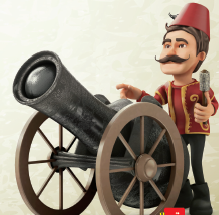The Ramadan cannon that accompanies the Adhan of Maghrib (call to sunset prayer), and Al-Fajr (dawn prayer) is more like a traditional painting embodying nostalgia and longing to a beautiful time and the old days. People nowadays rejoice to hear the sound of the Ramadan cannon because it carries many human and historical meanings to them as a Ramadan tradition. The majority
of the Arab and Islamic countries are keen to adhere to this tradition; its boom brings joy to the hearts of believers who gather before the time of breaking the fast around the table, with tongues praying for their Lord to accept their fasting and prayers. The origin of the Ramadan cannon dates back to Sultan Mahmoud II era. It is stated that in Cairo in the Khedive Ismail era, some soldiers
were cleaning a cannon when unwarily a shell was fired in the skies of Cairo. Incidentally, this was the time of the Adhan of Maghrib on a Ramadan day. The Egyptians thought that the government order had been issued, and that it was a new tradition to announce the time of Iftar (fast-breaking meal ) in addition to the Adhan. People started talking about this incident , and Haja Fatima, the daughter of Khedive Ismail, was impressed by that and issued a Faraman (a decree) that the cannon would shoot at Iftar and Suhoor time, latter, they added on holidays. Since then, the Ramadan cannon has been launched from the citadel of Saladin in Cairo.
In Beirut, in the last century, as the population of Beirut increased there was a great need for a means to let the people know about the start of Ramadan to prepare for fasting, and to announce the
timing of breakfast and Suhoor, as the radio was not yet introduced to Beirut in (radio was first introduced to Beirut in 1928). Therefore, Ibrahim Pasha gave the orders to shoot a cannon in the
state of Beirut to inform people that the start of the month of Ramadan proved legitimate. On the evening of 29th of Sha’ban or the 30th of it, the cannon would shoot 21 cannonballs to announce the appearance of Ramadan crescent and the same number of shots with the crescent of Shawwal to celebrate the Eid al-Fitr. It also fired 21 cannonballs on the evening of the ninth of Dhu al-
Hijjah, a tribute to the coming of Eid al- Adha. Hence, the cannon deserved the name “the cannon of Ramadan and two Eids”
One of the most famous desserts made in Ramadan is “Al-kalaj”, which is one of the distinguished Ottoman Turkish desserts, dating back to hundreds of years and known in both Damascus and Turkey. At the beginning, the dessert was known as “Kel Ash” or “Rose dessert” or “Rose Water” either because the recipe included the rose leaves or rose water, or because they looked like rose leaves. After using the name for years, and as it became common for people, the name was changed to the easier to pronounce “Kalaj”. It is stated in historical resources that the kalaj was made for the first time in 1489, when one of the Ottoman sultans gave orders to make a unique kind of desserts to be a special meal for Ramadan, the secret of the spread of this dessert in this month. The kalaj is special kind of dough, made of cornstarch, lined with overlapping layers, with milk, rose water, raspberry, and various kinds of nuts. Now, Turkey annually produces about 300 tons of kalaj, of various types and shapes, fried and wrapped, with milk and nuts.


Leave a Reply